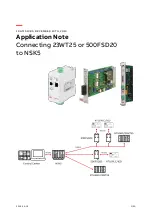
FSK 9601
Page 3
NF-filter:
8 bit wide, 512-tap FIR-Filter in the transmitter with 64-fold oversampling (DK9SJ-type). Active lowpass filters in TX and RX.
All inputs and outputs to the radio are filtered with R-C-R filters for EMI suppression. A FSK-filter (raised cosine rolloff) and a
GMSK filter are selectable by a jumper.
Modem interface (digital):
CMOS -level 5 volt. TXData, TXClock, RXData, RXClock, RTS CTS, DCD, + 5 volt,
reset, ground. Connector: 20 pin (2x10) ribbon connector.
LED display:
DCD (carrier detect), PTT (transmitter keying)
Jumpers and trimmers:
4 jumpers for PTT-keying, bit-Error-test, FSK/GMSK filter and spare filter select. Setting of output voltage with a 20 turn trim-
mer.
Watchdog:
The PTT-switch is time-limited to approx. 15 seconds. In case of failure of the TNC, the PTT is released after the maximum
time. For tests or special applications (digipeaters with long transmission periods) the watchdog may be disabled by a solder
jumper.
Jumpers on board:
AF-output muting on/off, baudrate 9600 / 19200 / 38400 / 76k8, 153k, 307k Baud, watchdog disable. Different TX and RX
baudrates are selectable.
Short description
A 'modem' contains
mo
dulator and
dem
odulator circuits.
The FSK9601 converts the digital signals of a packet-radio-controller to low-frequent tones, which can be transmitted by a FM
radio. Further, it decodes the tones received by a FM radio and sends them to the packet radio controller in digital form.
The modem FSK9601 generates and receives AF signals according the G3RUH-recommendations, which is usual with ama-
teur radio on terrestrial and satellite links. all frequencies are quartz controlled, adjustments are not necessary. The audio
bandwidth of the signal goes from 30 Hz to 5000 Hz (9600 bit/s. With other baudrates, the bandwidth is higher or lower ac-
cording to the speed.)
The transmit clock frequency (9600 Hz) is generated in the modem. The modem includes also the circuitry for transmitter-
keying (PTT) and transmit-time limiter (watchdog).
Bit-rate and baudrate
In this manual, the expressions bit-rate (bit/s, bit per second) and baud (Bd) are used for determining the transmission speed.
With the FSK9601 both values are equivalent, as there is exactly 1 bit transmitted with every clock cycle. In general, it is
possible to transmit more than 1 bit per clock, the speed (in bit/s) is then a multiple of the clock rate.
Digital interface - 20 pin connector
Pin Signal
Function
Pin Signal
1
+ 5 Volt
power supply 5 volt 150 mA (from TNC)
2
Ground
3
+ 5 Volt
power supply 5 volt 150 mA (from TNC)
4
Ground
5
Reset
(not used in FSK9600)
6
Ground
7
DCD
AF carrier detect (from modem to TNC)
8
Ground
9
CTS
transmitter is keyed (from modem to TNC)
10
Ground
11
PTT
transmitter keying (from TNC to modem)
12
Ground
13
TXD
transmit data (from TNC to modem)
14
Ground
15
RXD*
receive data (from modem to TNC)
16
Ground
17
TXC
transmit clock (from modem to TNC)
18
Ground
19
RXC*
receive clock (from modem to TNC)
20
Ground
*: RXD and TXD can be encoded NRZ as well as NRZI.
Signal description digital interface
Reset (Pin 5):
(modem input) normally high, is pulled low for 50 ms at power-on of TNC3. (not used in FSK9601)
DCD (Pin 7) Data Carrier Detect:
(modem output) High: modem receives no carrier, low: modem has locked on a G3RUH-
signal.
CTS (Pin 9) Clear to Send:
(modem output) Normally high. If the modem is ready to transmit data, the signal is low. With the
FSK9600, CTS output is connected to PTT input. The TNC will wait for CTS=low before data transmission starts.
PTT (Pin 11) Push to talk,
or RTS (Request to send)
:
(modem input) normally high. When the transmitter is to be keyed, the
TNC pulls this signal to low.
TXD (Pin 13) Transmit Data:
(modem input): The data is latched at rising edge (low to high transition) of transmit clock.
RXD (Pin 15) Receive Data:
(modem output): The data output changes at the falling edge and is valid at the rising edge (low
to high transition) of the receive clock.
TXC (Pin 17) Transmit Clock:
(modem output): The modem generates a clock frequency, which determines the transmit
baudrate and the data speed between TNC and modem. Transmit data signal TXD has to be stable at the rising edge of TXC.
Содержание FSK-9601
Страница 8: ...FSK 9601 Page 8 Schematics Modem FSK9601 C...



























